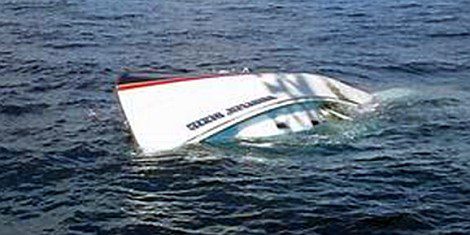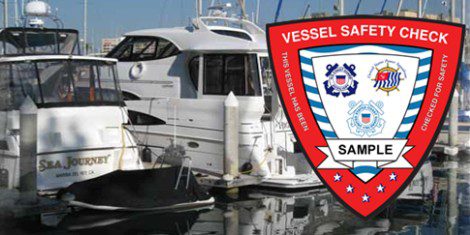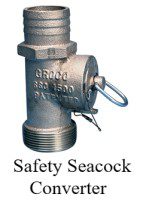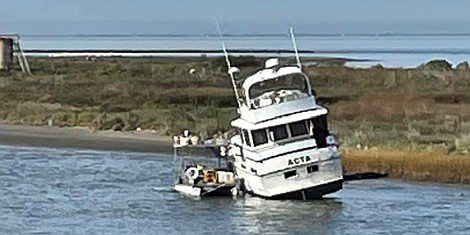 By Bob Currie, Recreational Boating Safety Specialist
By Bob Currie, Recreational Boating Safety Specialist
U. S. Coast Guard Auxiliary Station Galveston Flotilla
Risk Analysis
One way in which people gauge the risk of what they are doing is to weigh the probability of an event happening against the severity of injury or death should the event occur and use that analysis to decide whether or not the risk is acceptable. Humans do this all the time, and most of the time the analysis is automatic and made without forethought. For instance, if your boat is close to the dock and you wish to exit the boat, you weigh the probability that you will be able to make the leap from the boat to the dock against the severity of injury or death should you not make it.
Perhaps the most famous risk analysis is the one made by Chief Brody in the movie, “Jaws.” Chief Brody’s analysis was instantaneous, and his analysis resulted in the proper decision, expressed by his saying, “You’re going to need a bigger boat.” Boaters are famous for making the wrong decision, though, as evidenced by the number of search and rescue missions we perform each year and by the number of boating fatalities and injuries. This column is about lowering your risk of sinking your boat and what you can do to mitigate the risk of injury or death if your boat does begin to sink.
Sink or Swim
The term sink or swim refers to a situation in which someone either must succeed by his or her own efforts or fail completely. This term plays itself out in reality quite often on the open seas; the possibility of sinking is something that all mariners should be prepared for. The further out into the ocean you go, the longer it will take for you to be rescued in most cases, unless there is someone nearby who is appraised of your situation and can find you on the water. You can greatly increase your chances of survival by being prepared for a situation in which you find that your boat is sinking. This column will address three distinct boat sinking subtopics: prevention, preparation, and response.
Prevention: There is No Such Thing as An Accident
The truth is, there is no such thing as an accident. However, calling something an “accident” implies that it happened randomly, by chance, and there’s nothing anyone could have done to prevent it. It’s a way of linguistically shrugging your shoulders and negating responsibility.” From leventhal-law.com/blog/ .
A better description of an event than “accident” would be an “unintentional injury.” Unintentional injuries should not, however, be accepted as an unavoidable reality. If you embrace the philosophy that there is no such thing as an accident, you can start on the path to preventing an unintentional injury. Let’s look at the Recreational Boating Accident Statistics for 2021, the last year for which we have full data:
- There were 767 reported incidents of boats flooding or swamping (81 deaths, 235 injuries)
- There were 598 reported incidents in which boats capsized (210 deaths, 226 injuries)
- There were 246 reported incidents in which boats sank (16 deaths, 41 injuries)
- The incidents above resulted in 307 deaths and 502 injuries
Operating on the theory that each incident above could have been prevented, let’s look at how the incidents could be prevented without going into the details of each incident. Keep in mind that the answer is in preventing a boat from flooding or swamping, as capsizing occurs when a swamped boat rolls over when it is completely swamped, and a capsized boat will sink below the waves if critical buoyancy is lost.

Known Causes of Sinking
Although we don’t know what we don’t know, you can learn the answers either from training or from experience. Training is a much better way to learn. Let’s look at some of the basic causes of sinking your boat:
- Failure to put the plug in. This happens daily across the US.
- Overloading your boat. Pay attention to that capacity plate.
- Improper weight distribution. Assign passenger seating and tell them not to move about while underway.
- Improper boat handling. So many ways to go wrong here. Taking on large waves at an improper angle is on of the most cited occurrences. Surfing a wave such that the wave fills the stern with water is another.
- Striking an object in the water. Don’t operate faster than you can see (think about it- if you see something in the water but can’t stop before hitting it, you are going too fast).
- Leaking hoses or propeller shaft seal. Maintenance, maintenance, maintenance.
- Operating in seas too rough for your boat or your skills.
- Fire. If you have a fire aboard, your fire extinguisher will give you the time you need to abandon your boat. One single fire extinguisher is often not enough to extinguish a fire. The term “burned to the water line” is often the case.
- Collision with another boat. This is high on the list, and often results in injuries or death along with loss of the boat. Follow the Rules of the Road.
- Weather. As the Gilligan’s Island theme song goes, “The weather started getting rough, the tiny ship was tossed …” Don’t operate in bad weather or if there is a likelihood the weather will change for the worse.
Prevention: Education and Training
Donald Rumsfeld served as Secretary of Defense from 1975 to 1977 under President Gerald Ford, and again from 2001 to 2006 under President George W. Bush. Donald Rumsfeld said, “There are known knowns. These are things we know that we know. There are known unknowns. That is to say, there are things we know we don’t know. But there are also unknown unknowns. There are things we don’t know we don’t know.”
One of the requirements for joining the Auxiliary is to take a recreational safe boater course. That is where I recommend that any boater, new or experienced, begin their boating education. Whenever I perform a Coast Guard Vessel Safety Check, one question on the form is whether or not the boat owner has taken a safe boater course. Some of the old heads will talk about remembering a course they took back in the sixties. Those guys are also the ones who first off the bat show me their “required” paddle when I inspect their boat. They might not have any of the actual required safety equipment, but they have that paddle. They are always shocked when I tell them that a paddle hasn’t been required for about 50 years. I always recommend that they take a boater safety course even if they did take one 60 years ago. After all, things change.
Training refers to actual on the water training. There are on the water training courses you can take. One course I took years ago was an American Canoe Association (ACA) course. I learned to judge current and its affect on my boat. I learned some boat handling that carried over to operating a powerboat. Other avenues for training include going out with an experienced mariner, especially in the area in which you intend to operate. I have been fortunate enough to be trained by both active duty Coast Guard crews and experienced Auxiliarists in order to be qualified as boat crew. Another type of training comes from experience, also known as self-training. The downside to self-training is that often you are learning from your mistakes. Self-training requires heavy risk analysis before trying it. Self-training often requires self-rescue, and that is not a good thing.
Prevention: The Checklist and Preventive Maintenance
If you are a private pilot, then you know the importance of having a checklist. You don’t just hop into your Cessna 152 and take off. You perform an extensive checklist examination of your plane because if anything goes wrong up their there is no paddle to get you back to the dock. Pilots also know how important preventive maintenance is.
In the boating world, there is a high percentage of boaters who don’t understand that their boats require preventive maintenance and inspection using a checklist. We rescue a lot of boaters who just put their boats in the water after months of winter storage. Sometimes it is engine failure and they just need a tow. Other times a boat will begin taking on water due to a rotting or loose hose. Both types of problems could have been avoided by simply using a maintenance and inspection checklist. Where do you find such a checklist, you ask? Why, right there in your owner manual! That said, I have the following recommendations for your checklist:
- Check the fluid levels (engine oil, hydraulic steering, hydraulic anchor)
- Check the propeller for damage and propeller nut cotter key in place
- Check steering movement
- Check the bilge pump operation
- Check the battery for proper charge (keep on smart charger when stored)
- Check all lights and electrical systems
- Check the fire extinguishers
- Check all hoses that connect through the hull for damage and tight clamps
- Treat the fuel with stabilizer before storage
- Check the fuel lines for degradation
- Tighten all accessible bolts and fasteners
- Replace oil and fuel filters
- Inspect grease fittings and add grease as needed
- Remove the propeller, check for fishing line, and check the lower unit seal
- Check cleats and eyes for secure mounting
- Check mooring lines for degradation
- Clean and check the hull for damage
- Check your boat trailer lights
- Check your boat trailer wheel lug nuts and tire pressure
- Lubricate your boat trailer wheel hubs (unless they are sealed hubs)
- Make sure to install your boat plug before launching

Prevention: The Vessel Safety Check
A Vessel Safety Check (VSC) is a courtesy examination of your boat to verify the presence and condition of certain safety equipment required by state and federal regulations. Examinations are not a boarding or law enforcement issue. We let you know if you don’t meet any of the requirements and it is up to you to correct any deficiencies.
The VSC has two distinct parts. Part one involves required equipment and documentation. Part two involves Coast Guard recommendations. We often find that the required safety equipment in older boats is either outdated or even nonfunctioning. For example, older life jackets become worn, damaged by UV light, or torn. Fire extinguishers with the gauge needle in the red no longer have enough pressure to function. Boat fires are a common cause of boating accidents. In 2021 there were 274 boat fires (not including boats at the dock) with 8 deaths and 139 injuries. Unless it is a small fire, the purpose of a fire extinguisher is to give you enough time to abandon your boat and get off an emergency call to the Coast Guard. Large boat fires cannot be extinguished or controlled with a single fire extinguisher in most cases.
Preparation: Being Ready for Sinking
No matter how carefully you plan, something may still go wrong. When things do go sour, your saving grace is being prepared for the event. Here are some basic preparations that will cover many incidents that could or do result in your boat sinking:
- Have an extra boat plug readily available.
- Have a secondary bailing mechanism. Often a bilge pump can’t keep up with a leak, but you can save the boat by having a secondary method of bailing.
- Have additional fire-fighting capability; two extinguishers or more, depending on the size of your boat.
- Quickly communicate to the Coast Guard that you are taking on water and are in danger of sinking. It may take a while, but we have saved many a boat by arriving with powerful water pumps. You should have a marine radio for this purpose. Cell phones just don’t cut it, as the three fishermen who recently spent 48 hours in the water fighting off sharks will tell you.
- Always wear your life jacket. It is very difficult to put on in the water.
- Prepare for immersion. If operating in cool water, wear layers of synthetic material clothing. Cotton does not insulate at all. Float coats are an even better option. They provide upper body protection from cold water as well as flotation. They aren’t cheap, but then how much is your life worth?
- If your boat capsizes and remains afloat, stay with the boat. Try to climb onto the hull. This will save you from sharks and help prevent hypothermia, two problems encountered this past week by three boaters who were attacked by sharks and became hypothermic in 80-degree water. Yep. It took 48 hours of exposure, but over time your body just can’t keep up and your core temperature drops to the point your organs begin to fail.
Response Phase
If, after all your due care to prevent your boat from sinking, you find yourself in that terrible situation, there are some things you can do to save your boat and by extension the lives of yourself and your passengers. The response phase involves recognizing that you have a problem and then acting appropriately for the situation. This is where knowing your boat and its handling characteristics is critical to prompt recognition of a problem. This will often manifest as sluggish response to helm changes, a wallowing feeling, and an increasing load on the engine as the boat takes on more and more water. Another hint is when your automatic bilge pump begins operating for no apparent reason. Here are some important steps to take when you realize your boat is taking on water:
- Have everyone don their life jackets. They should already be on, but some people just don’t understand the danger of not wearing a life jacket.
- Notify the Coast Guard. This could be your only chance to get off a distress message. The Coast Guard will monitor the situation and send help if you reach the point where you are sinking.
- Find the leak. Check your bilge for hose leaks. Check below deck accesses.
- Slow the leak. There are leak kits available for large boats, but if you have a hull breach that you can reach from either inside or outside the hull, stuff some rags in the hole to slow the leak.

- Use crash pumps. You can disconnect the raw water intake for your inboard engine and, provided the engine is still running, use a safety seacock converter to pump out the bilge. A safety seacock converter allows instant emergency bilge pumping plus winterization and cooling system flushing.
- If still underway, trim to slow the flow. If the hull breach is at or near the bow, trim the bow up, and if it is at the stern, trim the bow down.
- Intentionally ground if near the shore. The boat in the picture below intentionally grounded due to a hull breach that the bilge pump couldn’t control.

Summary
Education, training, and routine maintenance are key to preventing sinking. If you still find your boat sinking, then good preparation and a quick response may still save you.
[Oct-18-2022]

 Posted in
Posted in 
























Excellent article.